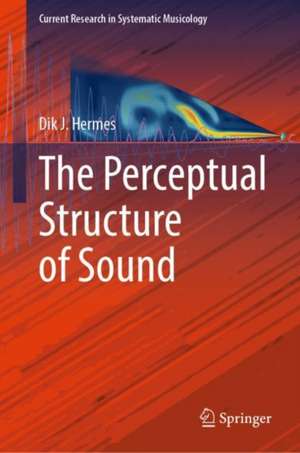The Perceptual Structure of Sound: Current Research in Systematic Musicology, cartea 11
Autor Dik J. Hermesen Limba Engleză Hardback – 11 iun 2023
This book presents a comprehensive review of how acoustic waves are processed by the auditory system into structured sounds such as musical melodies, speech utterances, or environmental sounds. After an introduction, an overview is given of how the ears distribute acoustic information over a large array of frequency channels that contain the auditory information used by the central nervous system to generate a mental image of what is happening around the listener. This process, called auditory scene analysis, consists of two stages. In the first stage, auditory units are formed such as musical tones and speech syllables. Each auditory unit is perceived at a well-defined moment in time, the beat location of that auditory unit. Moreover, from this process of auditory-unit formation, the auditory attributes of these auditory units emerge, such as their timbre, their pitch, their loudness, and their perceived location. Each of these attributes is discussed in the corresponding chapter.
In the second stage of auditory scene analysis, auditory-stream formation, the successive auditory units are integrated into auditory streams, i.e., temporally structured sequences of auditory units that are perceived as emanating from one and the same sound source. Examples of such auditory streams are musical melodies and the utterances of one speaker. The temporal structure of an auditory stream, its rhythm, is determined by the beat locations of its auditory units. The role played by the auditory attributes of the consecutive auditory units is discussed. The melodies of musical streams and the intonation contours of spoken utterances emerge from this process. In music, the beats of parallel streams generally fit into a metric pattern, and, depending on harmony, simultaneous tones can be perceived as consonant or dissonant.
Finally, the book contains many sound examples including the MATLAB scripts with which they are generated.
Preț: 958.41 lei
Preț vechi: 1418.78 lei
-32% Nou
Puncte Express: 1438
Preț estimativ în valută:
183.41€ • 191.24$ • 152.43£
183.41€ • 191.24$ • 152.43£
Carte indisponibilă temporar
Doresc să fiu notificat când acest titlu va fi disponibil:
Se trimite...
Preluare comenzi: 021 569.72.76
Specificații
ISBN-13: 9783031255656
ISBN-10: 3031255658
Pagini: 827
Ilustrații: XIX, 827 p. 289 illus., 247 illus. in color.
Dimensiuni: 155 x 235 mm
Greutate: 1.52 kg
Ediția:2023
Editura: Springer International Publishing
Colecția Springer
Seria Current Research in Systematic Musicology
Locul publicării:Cham, Switzerland
ISBN-10: 3031255658
Pagini: 827
Ilustrații: XIX, 827 p. 289 illus., 247 illus. in color.
Dimensiuni: 155 x 235 mm
Greutate: 1.52 kg
Ediția:2023
Editura: Springer International Publishing
Colecția Springer
Seria Current Research in Systematic Musicology
Locul publicării:Cham, Switzerland
Cuprins
Introduction.- The Ear.- The Tonotopic Array.- Auditory-Unit Formation.- Beat Detection.- Timbre Perception.- Loudness Perception.- Pitch Perception.- Perceived Location.- Auditory Stream Formation.- Interpretative Summary.
Textul de pe ultima copertă
This book presents a comprehensive review of how acoustic waves are processed by the auditory system into structured sounds such as musical melodies, speech utterances, or environmental sounds. After an introduction, an overview is given of how the ears distribute acoustic information over a large array of frequency channels that contain the auditory information used by the central nervous system to generate a mental image of what is happening around the listener. This process, called auditory scene analysis, consists of two stages. In the first stage, auditory units are formed such as musical tones and speech syllables. Each auditory unit is perceived at a well-defined moment in time, the beat location of that auditory unit. Moreover, from this process of auditory-unit formation, the auditory attributes of these auditory units emerge, such as their timbre, their pitch, their loudness, and their perceived location. Each of these attributes is discussed in the corresponding chapter.
In the second stage of auditory scene analysis, auditory-stream formation, the successive auditory units are integrated into auditory streams, i.e., temporally structured sequences of auditory units that are perceived as emanating from one and the same sound source. Examples of such auditory streams are musical melodies and the utterances of one speaker. The temporal structure of an auditory stream, its rhythm, is determined by the beat locations of its auditory units. The role played by the auditory attributes of the consecutive auditory units is discussed. The melodies of musical streams and the intonation contours of spoken utterances emerge from this process. In music, the beats of parallel streams generally fit into a metric pattern, and, depending on harmony, simultaneous tones can be perceived as consonant or dissonant.
Finally, the book contains many sound examples including the MATLAB scripts with which theyare generated.
Caracteristici
Is a self-contained monograph on sound perception connecting many fields of hearing research Covers many aspects which are illustrated by sound examples and demonstrations to be used in research, lectures Includes an introduction to the concepts of hearing research such as pitch, loudness, timbre, tonality











